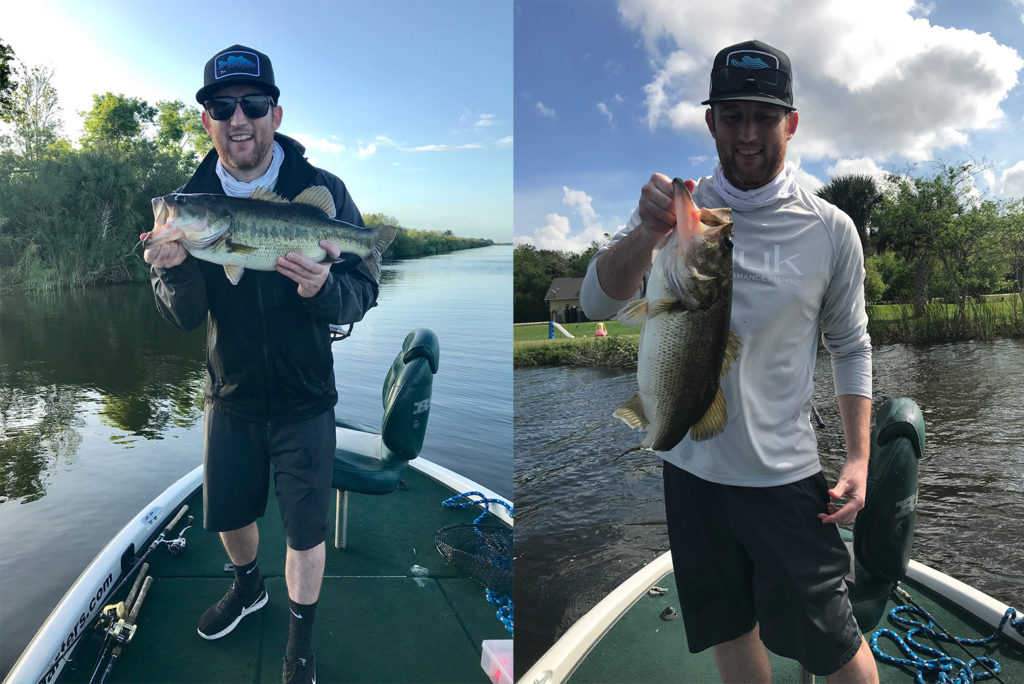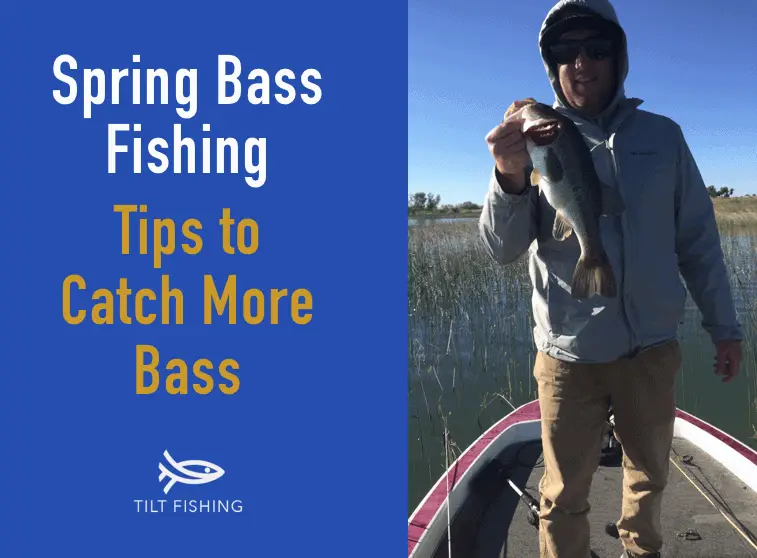The spring is one of the most exciting times of the year in bass fishing. The fish activity begins to pick up after a long, cold winter season and the bass begin feeding up as they prepare for the spawn.
The spring offers anglers with some unique fishing opportunities and challenges and is one of the best times of the year to catch your biggest bass of the season. The spring is prime time bass fishing.
In this article I’m going to share with you 15 fishing tips that will help you catch more fish this spring.
Let’s get started.
15 Spring Bass Fishing Tips to Catch More Fish
1. Cover Water
Covering water is always a good approach in bass fishing, but it’s especially important in the spring. In the spring time weather can be unpredictable and bass are constantly on the move as they prepare, go through and recover from the spawn.
They can easily move up shallow one day and move back the next as weather patterns change. It’s almost impossible to predict where the bass will be positioned on a given day.
Because of this, you’ll be way more effective if you cover water with a search bait (any moving bait) and try different areas. When you do find some bass, then you can slow down pick apart the key spots and start developing a pattern.
Make sure to check out My Recommended Bass Fishing Gear and Tackle Guide to ensure you have the right gear for your next fishing adventure.
2. Understand the 3 Phases
The spring can be split up into three important phases; pre-spawn, spawn and post pawn. Understanding and adapting to each of these phases is critical and is something that should always be on your radar in the spring.
Here is a breakdown of these three phases:
Pre-spawn (48 to 55 degrees)
After the long winter months as the water temperatures start to get into the high 40’s and low 50’s bass will leave their winter haunts and start moving towards the shallower areas where they are eventually going to spawn.
In between where they hung out in the winter and where they are going to spawn is where they start feeding heavily. This can be some of the best bass fishing of the year.
Reaction baits like spinnerbaits and lipless crankbaits that closely resemble what the bass are feeding on is a great way to catch bass in the pre-spawn during the early spring.
Spawn: (55 to 70 degrees)
When water temperature start getting into the mid 50’s to 70 degrees. The male bass will start moving up to the shallower areas to spawn and will begin building their nests followed by the females shortly after to lay the eggs.
During this time period bass aren’t necessarily looking to actively feed, they did most of that in the pre-spawn phase. However, they are super aggressive and territorial and will still strike lures which can make for some really exciting shallower water fishing.
Post-spawn: (70 to 75 degrees)
Once water temperatures start getting above 70 degrees the majority of the bass will finish up spawning and will head out to deeper water toward their cooler summer time hangouts.
This typically begins with the female bass. Where they will head out deeper and start to recover from their spawning activities. The male bass will follow after once they are done guarding the eggs and fry.
Although they don’t feed as heavily during the post-spawn, they do still need to feed quite a bit to be able to recover from the spawn. This can present some great fishing opportunities as well.
3. Find Where Bass Will Spawn
Bass fishing in the spring is all centered around the spawn. If you can identify where the bass in your lake, pond or reservoir are going to be spawning, you can then back track and figure out where they are at.
Bass need three main things to spawn; hard bottom, protected areas (from wind/current) and sunlight. On most bodies of water this will occur in coves and shallow protected flats.
If I am fishing around the spawn, I always check shallow water fist with a square-bill or a jerkbait. But if I can’t find any fish there, I’ll move on to the first secondary point and work my way back deeper until I can locate where the bass are at.
Start shallow and work your way back to their winter spots until you can dial in where they may be holding. This will allow you to eliminate water, baits and lures and make you a more productive and efficient angler.
4. Target Transition Areas
One of my favorite spots to target bass in the spring is what I call transition areas. Transition areas are often referred to as bass highways and rest stops.
They’ll use these areas as they head toward their spawning areas and once the spawn is over they’ll use them again as they transition to where they will spend their summer.
Here are some key transition areas to look for:
- Bridges
- Chunk Rock to Gravel
- Rip Rap to Sand
- Secondary Points
Any type of structure before spawning areas
These transition areas are proven to hold a ton of bass during the spring and are great spots to catch some big fish. Give these areas a shot the next time you hit the water.
5. Moon Phases
Another important spring bass fishing tip that you should always keep in mind is the importance of moon phases and how they come into play in the spring. If the conditions are right most bass will prefer to spawn near the full moon or the new moon.
The moon for whatever reason cause the bass to progress through their spawning activities and head shallow. Keep this in mind as your searching for bass in the spring. Because you may be find them out deep one day and then all of a sudden a full moon hits and will pull up and start to spawn.
6. Build a Pattern
Spring bass fishing is all about moving quickly, finding schools, building a pattern and then running that pattern on other parts of the lake. That is how you are going to catch the most fish and run into the really big bass.
Start off throwing reaction style baits that will allow you to cover water quickly. Once you get a few bites you can start to slow down and dial in the cadence, technique and color the bass are wanting.
Learn to pay attention to the smallest of details whether it be positive or negative feedback. These subtle clues can give you a huge advantage if you learn to recognize and follow what the bass are telling you.
Check out this article by Bass Resource: Establishing A Pattern for more information about building and following a fishing pattern.
7. Target Big Bass

The spring is prime time and is one of the best opportunities you’ll have all year to catch a giant bass. This is the time of year where you get your best shot at catching your (PB) personal best but if you are not careful you might miss this opportunity.
As long as your fishing you have the chances to catch a giant, but if you want to dramatically increase your odds at catching big fish you need to be throwing the right baits.
Here are some of the best baits to use in the spring for big bass:
- Alabamba Rig
- Big Swimbaits
- Spinnerbaits
- Jerkbait
- Crankbaits
Take advantage of some of the best fishing of the year this spring and throw these baits and you’ll have a great shot at catching the biggest bass of your life.
8. Slow it down
In the early spring before the water has had a chance to warm up slow down your retrieve. The cold water slows down the bass’s metabolism; resulting in less energy and will move at slower speeds.
When faced with fast moving baits bass will likely pass due to their sluggish state. Slowing down your retrieval will make your bait look more natural and the bass will be more likely to take advantage of an easy meal.
9. Find Warm Water
Water temperature can play a big factor in the spring and it’s something that you should always keep an eye on. Sometimes, especially in the early spring water that’s even just one-degree warmer will hold most of the bass and can influence their behavior.
These warmer areas on the water hold a lot of fish and can make for some unbelievable days out on the water. Get out there and find these warmer spots and you’ll have a lot of success this spring.
10. Watch for Birds
When bass fishing in the spring pay close attention to the wildlife around you. If you can see areas where birds are diving and catching a meal. These are often great spots where hungry bass congregating and where lures like crankbaits, jerkbaits and spinner baits will be the most effective.
11. Use the Wind to Your Advantage
In the spring the wind can make for some cold and perhaps tough fishing conditions. Most anglers tend to shy away from the wind and head to a protected cove. This can be a big mistake.
While the wind can make it difficult to cast and navigate your boat, it also gets things going, stirs up the water column, puts oxygen in the water and gets the baitfish moving. All of these factors can make for some great bass fishing opportunities.
The next time your faced with windy conditions head to the windiest bank you can find and throw one of these lures and get ready for some action.
12. Use Search and Reaction Baits
Spring bass fishing is all about covering water and building patterns. In order to do that effectively and efficiently, you’ll want to have right baits and lures tied on.
Here are five different style of baits that will help you cover water and catch a bunch of bass this spring:
- Jerkbaits
- Lipless Crankbaits
- Glidebaits
- Squarebill Crankbaits
- Deep Crankbaits
13. Down Size Your Bait
While power fishing and covering water with glidebaits, crankbaits, spinnerbaits is one of the most effective ways to fish in the spring. There are going to be days where the bite is tough and conditions aren’t ideal.
In this case, downsize your lures and go more finesse. Something like an underspin paired with small swimbait can be a great way to still cover water, but get those finicky bass to react. If bass still won’t react, you may want to slow down and use a tube, dropshot, ned rig or senko.
14. Match the Hatch
Another great way to catch more bass in the spring is to “match the hatch”. Matching the hatch basically means to use baits that closely resembles the type of forage the bass have available to them and will be feeding on.
Whether it’s small bait fish, crawdads etc. finding out what the bass are eating and focusing on will give you a huge advantage and you’ll end up having a lot more success if you can closely mimic it.
Here are some basic tips on matching the hatch: How to Properly Match the Hatch to Catch More Bass.
15. Color is Key
Another helpful bass fishing tip that will help you catch more bass this spring is choosing the right color. A small color change can be a huge difference maker.
One of my favorite colors in the spring is red. I love throwing red crankbaits and spinnerbaits. For whatever reason the red color really gets the bass fired up. But there are a lot of other great colors to choose from.
Here is a color guide that will help you make the right color choice based on the different fishing conditions you may face.
Spring Bass Fishing Color Chart
| Sunny & Clear | Cloudy & Clear | Sunny & Stained | Cloudy & Stained |
| Chrome, Metallic Ghost, Flashy & Reflective | Ghost, White, Red Dark Green, Dark Natural colors | Chrome/Metallic Flashy & Reflective, Chartreuse , Red & White | White, Chartreuse Black & Blue, Black & Red, Purple |
Having the right color of lure or bait tied will give you the best chance at catching a bunch of bass this spring.
For more information on choosing the right color in the spring check out this article: What Colors Do Bass Like in the Spring?
Other Spring Bass Fishing Resources
- Top 25 Bass Fishing Tips for Beginners
- How to Catch Smallmouth Bass: A Complete Beginners Guide
- How Do You Catch Bass When They Aren’t Biting?
- 3 Tips for Early Spring Bass Fishing
Final Thoughts
The spring months are a great time to be a bass fishing angler. The bass become more active as the water temperatures rise and will feed heavily as they prepare for the spawn as well as after as they recover.
While this is one of the best time of year to be fishing for bass the spring season also presents anglers some unique challenges and you’ll never know what kind of weather you might get.
With these 17 spring bass fishing tips you’ll be able to take advantage of the great fishing opportunities you’ll have in the spring and be able to adapt to the different obstacles you may face.
Tight lines

